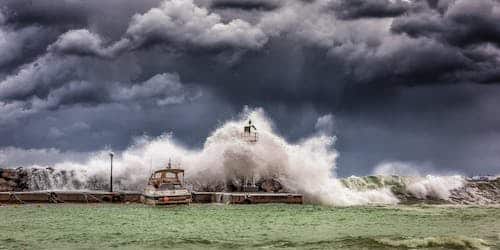Too many homeowners believe they do not require flood insurance. According to the National Association of Insurance Commissioners, only approximately 5% to 15% of homeowners have it. However, according to the most recent FEMA data, flooding affects 99% of counties in the United States.
To make matters worse, many homeowners believe their home insurance already covers flood damage. However, flood damage is not covered by a normal home insurance policy.
If your home is flooded, you could face a significant financial calamity if you do not have flood insurance. To put this in context, according to the most recent FEMA data, the average payout on a flood claim from the National Flood Insurance Program (NFIP) is $52,000.
What Is Flood Insurance?
Flood insurance is a type of property insurance that covers damages caused by water damage, specifically flooding. Flooding can occur as a result of severe or persistent rain, melting snow, coastal storm surges, clogged storm drainage systems, or levee dam failure.
A flood is regarded as a catastrophic and significant occurrence in many places, and the damage or devastation it produces is not covered if you do not have additional insurance.
What Does Flood Insurance Cover?
Flood insurance is divided into two categories: dwelling (your house) and contents (your belongings). Depending on where you buy your flood insurance, you may be able to purchase a building-only policy, a contents-only policy, or both.
#1. Dwelling Protection
Dwelling coverage, often known as building coverage, pays to restore or rebuild your home following flood damage. For example, if flood water damages your electrical and plumbing systems, a flood insurance policy’s dwelling coverage will pay to repair or replace them.
The NFIP’s flood insurance policy limits residence coverage to $250,000. In the private market, you may be able to purchase greater levels of home coverage. Flood Guard, for example, sells policies with up to $5 million in dwelling coverage, while Neptune Flood Insurance offers plans with up to $4 million in dwelling coverage.
#2. Contents Coverage
Personal property coverage, commonly known as contents coverage, protects your personal possessions, such as furniture, clothing, and appliances. For example, if flood waters ruin your living room furnishings, a flood insurance policy’s contents coverage will pay to repair or replace the items.
The contents coverage under an NFIP flood insurance policy is limited to $100,000. Higher content coverage may be available on the private market. Flood Guard and Florida Peninsula Insurance Co., for example, offer up to $1 million in content coverage.
Basics of FEMA Flood Insurance for Residential Properties
| Coverage | FEMA flood insurance policy |
| Building coverage limit | $250,000 |
| Contents coverage limit | $100,000 |
| Waiting period for coverage after you buy (there are some exceptions) | 30 days |
| Building and contents coverage deductible choices | From $1,000 for each (no discount) to $10,000 for each (40% discount) |
| Loss of use | None |
What Does Flood Insurance Not Cover?
Flood insurance does not cover all kinds of water damage. Typically, an NFIP flood policy does not cover:
- Burst pipe damage (this form of damage is covered by home insurance).
- Decks, patios, swimming pools, septic systems, and landscaping are examples of personal property located outside of your building.
- Mold and mildew that can be avoided.
- Additional living expenses such as hotel housing.
- Cars that have been damaged (the comprehensive component of your auto insurance policy will cover flood-related car damage).
How Does Flood Insurance Work?
A flood insurance policy is a sort of catastrophe insurance that differs from the basic hazard insurance coverage included in a homeowners insurance policy. Flood insurance is offered for all residential and business properties.
Standard homeowner’s insurance typically covers interior water damage due to storms or broken pipes. However, it often does not cover flood-related destruction or damage. Property owners who live in a flood-prone location should normally obtain specific insurance.
Flood insurance functions similarly to other types of insurance. The insured (the property owner) pays an annual premium based on the flood risk of the property and the deductible they select.
The homeowner is covered if the property or its contents are damaged or destroyed by floods caused by an external event such as rain, snow, storms, or collapsed or failed infrastructure. They receive compensation for the cost of repairing the damage and/or rebuilding the structure, up to the policy limit.
In contrast to a conventional homeowners policy, flood insurance requires a policyholder to purchase two policies to cover a property and its belongings. A separate coverage rider is necessary if rising floodwaters are not the cause of the sewage backlog.
Flood insurance is necessary coverage for a federally backed mortgage on a property in a federally designated flood zone (a region prone to flooding due to heavy rainfall, flash flooding, and mudslides).
National Flood Insurance Program (NFIP)
The Federal Emergency Management Agency (FEMA) manages the National Flood Insurance Program (NFIP), which provides flood insurance to homeowners in participating municipalities and those in NFIP-designated floodplains. Private insurance companies, not the NFIP or FEMA, issue the real insurance policy.
The Federal Emergency Management Agency (FEMA) updates maps of flood zones in the United States, which are locations that are most prone to flooding. FEMA updates the zones when new and intensifying weather patterns emerge. For rating purposes, the zones are divided into subsections. Flooding is a moderate to low risk for properties in flood zones B, C, and X. Low risk indicates there is less than a 1% possibility of flooding each year.
Properties located in zones denoted by an A are deemed high-risk. They are further subdivided, with descriptions of anticipated floodwater heights and predicted rates of occurrence over a 30-year mortgage. Properties with a V designation are comparable to those in zone A. These are high-risk regions located around the coast.
Some homeowners may be in Zone D, indicating that a decision has not yet been made for the region. Flood zone maps are constantly being revised to account for shifting weather patterns and man-made environmental modifications such as dams and levees.
You can determine your flood zone by going to Floodsmart.gov and comparing a property address to the flood map service center.
How to Purchase Flood Insurance
There are two options for obtaining flood insurance:
- The National Flood Insurance Program (NFIP) is FEMA’s federal scheme. The National Flood Insurance Program provides flood insurance to the vast majority of homeowners. Your home insurance agent will be able to process your policy application.
- Some companies offer private personal flood insurance. They may offer coverage options not available through FEMA, making them ideal for customers with large or expensive properties or who just find the FEMA options insufficient.
The NFIP is mandated to accept all applicants who live in NFIP-eligible communities. Private insurers can be picky about who they sell to. Finally, if your property has previously experienced flood damage or you live in a high-tide flood zone, your options will most likely be restricted to a FEMA policy.
When Should I Purchase Flood Insurance?
If you have a mortgage and reside in a high-risk flood zone, your lender may mandate flood insurance, but coverage may be a wise choice even if you live in a low- or moderate-risk flood zone.
Homes outside of high-risk areas are nonetheless vulnerable to flooding. According to FEMA, one-third of flood insurance claims come from low- or moderate-risk flood zones. Flood insurance costs are lower if your property is not at risk of flooding.
What Type of Flood Insurance Do I Need?
FEMA flood insurance policies have defined coverage limits, but if you believe you need extra coverage, you can supplement it with a private flood insurance policy.
Perhaps the cost of rebuilding your home exceeds the $250,000 FEMA policy limit. Alternatively, you may require more than $100,000 in content coverage.
In such circumstances, contact private flood insurance firms and purchase coverage that extends beyond FEMA flood policies.
#1. Commercial Flood Insurance
A normal small business insurance policy will not cover flood-related losses if you own a business. A separate flood insurance policy is required.
The NFI P’s commercial flood insurance policy includes:
- Construction property up to $500,000.
- Personal belongings worth up to $500,000.
A business flood insurance policy’s building property element covers flood damage to your building, including:
- Canopies and awnings.
- The structure and its foundation.
- Central air conditioning, heaters, and ventilation systems.
- Plumbing and electrical systems.
- Sprinkler and fire extinguishing systems.
- Aerials and antennae are mounted on the building’s exterior.
- Carpet that has been permanently laid over an unfinished floor.
- Paneling, bookcases, cabinets, and wallboard.
- Freezers on wheels.
- Water heaters.
A commercial flood insurance policy’s personal property section covers flood damage to things such as:
- Certain precious things, such as artwork and furs (up to a total of $2,500).
- Clothes, washing machines, and dryers.
- Food freezers and the contents of food freezers (walk-in freezers are protected under building property coverage).
- Fixtures and furniture.
- Equipment and machinery.
- Non-licensed self-propelled vehicles (such as a tractor) are kept inside your structure.
- Dishwashers that are portable.
- Microwave ovens that are portable.
- Window and portable air conditioners.
- Other personal property that you own and utilize for business.
- Merchandise, raw materials, in-process, and finished commodities are examples of stock.
You can check out our post to learn more about commercial insurance policy
Personal property is paid the actual monetary value under NFIP commercial flood insurance coverage. This accounts for depreciation.
The following are not covered by an NFIP commercial flood insurance policy:
- Currency, precious metals, or valuable documents, such as stock certificates and recorded data, are examples of valuable papers.
- Financial losses caused by a business interruption or loss of property use.
- Moisture, mildew, or mold damage that the property owner might have averted.
- Damage caused by sewer or drain backups, unless the backup was caused by a flood in the region.
- Outside property and belongings, such as decks, fences, hot tubs, patios, plants, seawalls, septic systems, swimming pools, trees, walks, and wells.
- Cars, trucks, and vans (with their parts) are examples of self-propelled vehicles. The comprehensive section of your commercial auto insurance policy would cover flood damage to work vehicles.
Commercial flood insurance may be available on the private market. Neptune Flood, for example, supplies commercial flood insurance to small and medium-sized businesses. You may get up to $4 million in coverage and up to $25,000 ($500 per day for up to 50 days) in business interruption insurance if you are unable to operate your firm due to a flood.
#2. Flood Insurance for Manufactured and Mobile Homes
Flood damage is not covered by a regular mobile home insurance policy. A separate flood insurance policy will be required. The NFIP may provide flood insurance for mobile and prefabricated homes with six different foundation types:
- Basement (nothing above ground).
- Crawlspace (subgrade crawlspace, elevated or not).
- Elevated enclosure supported by piers, piles, or posts.
- Elevated on piers, piles, or posts without enclosure.
- Elevated enclosure that is not supported by piers, piles, or posts (solid foundation walls).
- Slab on a non-elevated grade.
The NFIP provides flood insurance for mobile and prefabricated houses up to $250,000 in structure coverage and $100,000 in contents coverage.
Although not all insurers provide it, you may be able to acquire flood insurance for mobile and manufactured houses on the private market. Mobile and prefabricated dwellings, for example, are ineligible for Neptune flood coverage.
#3. Condominium and cooperative housing flood insurance
A normal condo insurance policy will not cover flood-related damage if you live in a condo. A separate flood insurance policy will be required. Flood insurance for condos is often classified into two types:
Flood insurance for the building and its contents
This encompasses the structure of the building as well as various interior things such as carpets, electrical systems, furnaces, heat pumps, and central air conditioning equipment.
Flood insurance is available through the NFIP for qualified buildings through a Residential Condominium Building Association Policy (RCBAP). An RCBAP does not apply to condominiums if 25% or more of the building is used for non-residential purposes, or to non-residential structures such as pool houses, clubhouses, and detached storage facilities. Coverage is restricted to $250,000 (multiplied by the number of units or the structure’s replacement cost, whichever is less) and $100,000 in commonly held building contents.
If your building is ineligible for flood insurance through the NFIP or you require higher limits than what the NFIP provides, you may be able to obtain flood insurance through the private market. For example, Neptune flood insurance provides RCBAP flood plans with building coverage limits of up to $2 million per unit/$2 million per structure and contents coverage of up to $500,000 per unit/$500,000 per building.
Personal Contents Flood Insurance
This does not cover personal goods in your flat, such as clothing, furniture, or electronics. The NFIP provides flood insurance through a “dwelling form,” and coverage is restricted to $250,000, with flood-damaged items compensated on an actual cash value basis, taking depreciation into account.
If you are unable to obtain flood insurance via the NFIP or want larger coverage, you may be able to obtain flood insurance for your personal belongings on the private market. For example, Neptune flood insurance provides condo unit owners with up to $500,000 in contents coverage.
#4. Renters Flood Insurance
A regular renters insurance policy will not cover flood damage if you rent your house. While your landlord’s flood insurance will cover structural flood damage, it will not cover flood damage to your personal possessions. If you want coverage for flood damage, you must get a separate flood insurance policy.
The NFIP’s flood insurance for renters is also known as contents coverage. You can obtain coverage up to $100,000, with fees starting around $100 per year. It will cover your personal belongings if they are damaged by a flood, such as:
- Mattresses and bed frames.
- Books.
- Clothing.
- Electronics such as your laptop, camera, and television.
- Pots, pans, microwaves, and mini-fridges.
- Portable washing machines and dryers.
- Window and portable air conditioners.
- Rugs.
- Jewelry and artwork (up to $2,500 in value).
If your belongings are damaged by a flood, you will be reimbursed on an actual cash value basis, which includes depreciation. If you are unable to live in your home due to a flood, your NFIP flood insurance does not cover additional living expenditures.
You must live in a community that participates in the NFIP to be eligible for an NFIP renters flood insurance policy. Flood policies from the NFIP have a 30-day waiting period before coverage begins, so purchase a policy as soon as possible.
If your municipality does not participate in the NFIP, you may be able to get a renters flood insurance policy from a private insurance firm.
Costs Flood Insurance
The NFIP oversees flood insurance policy pricing, and the cost will not vary between issuers. If you live in a flood zone or a town that participates in the NFIP, the NFIP can assist you in choosing an insurance agent.
Your agent will consider criteria like as the location and structure of your property, especially its proximity to a body of water and its elevation, when determining the cost of your policy. The type of coverage you choose, such as replacement cost value versus actual cost value, will also have an impact on costs.
Pricing can be influenced by factors such as the flood zone classification, the age of the property, and the number of floors. A Preferred Risk Policy (a low-cost flood insurance policy) covers both the building and the contents of a property in a moderate-to-low-risk area for a single payment. Certain municipalities that have undertaken flood-prevention measures are also eligible for NFIP discounts. As a result, annual premiums can differ greatly.
The maximum for residential structures under NFIP insurance is $250,000 in building coverage and $100,000 in contents coverage. Businesses can get up to $500,000 in building coverage and $500,000 in content coverage.
Of course, you can always obtain coverage on your own, especially if you wish to insure your property for a higher sum (rates for additional coverage, however, will not be regulated). Starting with the company that issues your regular homeowners policy is often a good option.
How Can I Get Low-Cost Flood Insurance?
#1. Select a Higher Deductible
The amount taken from your insurance claim check is known as the deductible. For example, if your property sustains $20,000 in flood damage and your deductible is $1,000, your insurance company will give you a check for $19,000.
Lower flood insurance costs derive from a higher deductible amount. You may also be eligible for a discount. FEMA, for example, gives up to a 40% discount if you choose the maximum NFIP flood insurance deductible for residential properties, $10,000.
#2. Reduce Your Flood Risk
If you make efforts to lower your flood risk, you may be eligible for mitigation discounts. FEMA, for example, provides discounts to homeowners who build flood openings and elevate equipment and apparatus (such as a hot water heater or central air conditioner) above the first level.
#3. Obtain a Certificate of Elevation
If you have an elevation certificate proving that your first floor is higher than the FEMA-determined first floor, you may be eligible for lower flood insurance costs.
#4. Community Discount of The NFIP
Based on the NFIP’s Community Rating System (CRS), over 1,000 communities qualify for lower flood insurance rates. CRS savings are based on activities taken by your municipality to mitigate flood risk, such as the establishment of floodplain management programs. Inquire with your insurance agent to see if your town participates in the CRS.
#5. Flood Insurance Comparison
The majority of homeowners who purchase flood insurance do so through the NFIP, but you may have other options in the private market. Obtaining flood insurance estimates from both the NFIP and private flood insurance companies is a good idea.
Is It Ever Too Late to Purchase Flood Insurance?
If you’re concerned about an oncoming storm or hurricane, you might wonder if it’s too late to purchase flood insurance. Some flood insurance policies have a 30-day waiting period, but you may be able to purchase flood insurance without one.
If you wish to buy an NFIP flood insurance policy, you’ll most likely have to wait 30 days. There are a couple of exceptions:
- If you purchase an NFIP plan in connection with making, extending, renewing, or increasing a home loan, there is no waiting time.
- There is no waiting period if you increase your coverage at the time of your NFIP policy renewal.
- If your property is threatened by floods on burned federal land and you acquire your plan within 60 days of the fire’s containment date, the waiting period may be waived.
- If your building is newly designated in a high-risk Special Flood Hazard Area and you acquire an NFIP plan within the 13-month period following a map modification, there is a one-day waiting time.
If the NFIP waiting period applies to you and you need flood insurance right away, you may be able to get it from a private insurer. The following private insurance companies provide flood insurance with no waiting period:
- Flood Protection
- Zurich Private Residential Flood Insurance
If you can’t locate flood insurance without a waiting period, you might be able to find one with a shorter one. Neptune Flood Insurance, for example, has a 10-day waiting period. The waiting period for a Private Market Flood is 14 days, however, it may be reduced in specific conditions, including by replacing an existing NFIP policy.
Renewing a Flood Insurance Policy
Flood insurance purchased through the NFIP does not renew automatically. The NFIP and your insurance company will send you renewal reminders in the weeks coming up to your flood policy’s expiration date. Every year, you will be responsible for renewing your policy. If you have a government-backed mortgage or live in a high-risk location, you must renew your NFIP flood insurance policy.
If you pay your flood insurance premiums through an escrow account, you can contact your mortgage lender to inquire about renewing or changing your policy.
So, if you let your NFIP flood insurance policy lapse, it will take 30 days for a new NFIP flood insurance policy to take effect, during which time you will not be protected from any flood damage.
If you buy flood insurance on the open market, your insurer should send you a renewal notification. Wright Flood Insurance, for example, will send you a renewal notification 45 days before your policy expires. You can also speak with your insurer directly about renewing your policy.
Conclusion
Whether or not flood insurance is a smart idea for you will depend on a number of criteria, the most important of which is whether your house is in a flood-prone location. Floods, on the other hand, are unpredictable. You don’t have to live near water for your home to flood due to storms, melting snow, or clogged drainage systems. Remember that if you want to protect yourself against the costs of flood damage, you must purchase a separate policy in addition to your home insurance.
- PROPERTY INSURANCE: What It Covers
- DWELLING INSURANCE: How Much Dwelling Coverage You Need
- HOW MUCH IS FLOOD INSURANCE: 2023 Price Guide






